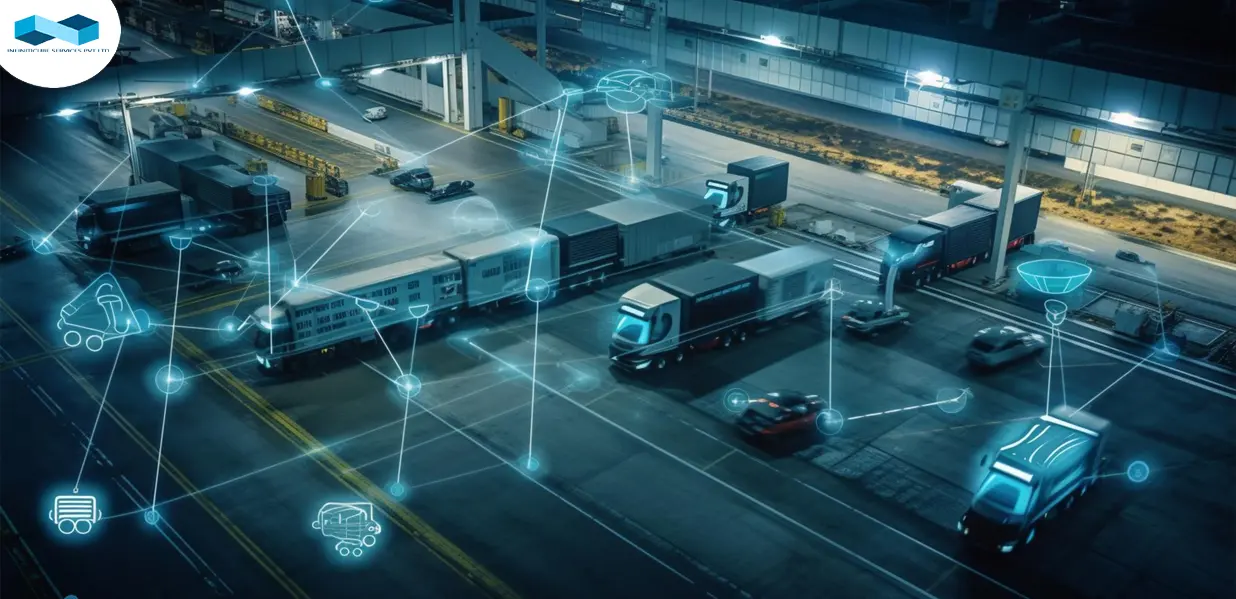The Top 10 Benefits of Digital Transformation in Logistics
Introduction:
The benefits of digital transformation in logistics, highlighting its significant impact on the industry. The focus is on efficiency and innovation reshaping logistics.
Unlocking the Benefits of Digital Transformation in Logistics
- Digital transformation revolutionizes logistics, enhancing operational efficiency through automation and optimization.
- Real-time data visibility guides decision-making, offering control and adaptability in logistics operations.
- Resource utilization is optimized with tools analyzing operational patterns for efficient logistics management.
- Predictive analytics in digital transformation helps mitigate risks and uncertainties in logistics operations.
The Intersection of Efficiency and Innovation in Logistics
- Efficiency is the engine, innovation is the fuel in logistics evolution
- Strategic innovation in the supply chain redefines logistics essence
- Smart warehouses, blockchain traceability crucial in logistics resurrection
- Human-machine collaboration key in logistics innovation
- Drones, AI integral in reshaping logistics processes
- Dynamic adaptability to market changes essential for survival
- Logistics networks pivot swiftly in response to market shifts
I. Digital Transformation for Logistics Efficiency
Leveraging Technology to Optimize Supply Chain Operations
- Digital evolution enhances logistics efficiency through technology in supply chain operations.
- Algorithms optimize supply chain operations by decoding data and identifying inefficiencies.
- Data-driven insights guide decision-making for efficient routes and operational strategies.
- Dynamic route planning adapts to real-time variables like traffic, weather, and market demands for efficiency.
Streamlining Logistics Processes with Automation
- Robotic precision in warehousing: Automated Guided Vehicles (AGVs) enhance operations with efficiency and finesse.
- Automated order fulfillment: Machines process orders seamlessly, reducing turnaround times.
- Predictive maintenance: Anticipates breakdowns through data analytics, ensuring proactive upkeep.
- Technology optimizes supply chain operations with automated efficiency, transforming logistics processes.
II. Supply Chain Optimization Strategies
Supply chain optimization goes beyond traditional methods. Focus on data analytics and digital inventory management.
Data Analytics in Supply Chain Decision-making
- Data is crucial in supply chain decision-making, acting as a digital revelation for professionals.
- Algorithms decode patterns within datasets, providing valuable insights beyond traditional methods.
- Real-time data illuminates the supply chain, aiding decision-makers in anticipating challenges and opportunities.
- Predictive analytics is key in foreseeing market trends and disruptions for proactive decision-making.
Inventory Management Solutions: A Digital Approach
- Inventory management in the digital era embraces innovative solutions
- Digital optimization ensures precise placement, movement, and replacement of inventory
- Smart forecasting algorithms analyze real-time data for accurate predictions
- Blockchain technology ensures transparency and traceability in the supply chain
- Data analytics guides real-time insights and transforms inventory into a strategic asset
- Digital inventory management becomes dynamic and responsive, optimizing logistics efficiently
III. Accelerating Logistics Speed with Technology
This section discusses how technology accelerates logistics speed, emphasizing real-time tracking and cost reduction strategies.
Real-time Tracking and Monitoring Systems
- Logistics evolves with real-time tracking and monitoring systems
- Satellite technology enhances tracking accuracy
- Embedded sensors monitor environmental conditions for cargo
- Predictive analytics anticipate and prevent delays in logistics operations
Transportation Cost Reduction through Advanced Strategies
- Transportation cost reduction involves maximizing efficiency and minimizing costs
- Advanced strategies redefine logistics by optimizing routes and load balancing
- Algorithmic route optimization considers factors like fuel efficiency and traffic patterns
- Dynamic load balancing distributes loads for optimal weight distribution
- Fuel-efficient fleet management systems optimize fuel consumption and embrace eco-friendly technologies
- Real-time tracking and cost reduction strategies revolutionize the logistics landscape
IV. Improving Customer Experience through Digitalization
This discusses how digitalization enhances customer experience by personalizing strategies and improving order fulfillment processes.
Personalization Strategies using Customer Data Insights
- Personalization strategies use customer data insights for customized experiences
- Algorithms analyze customer data to create tailored recommendations
- Behavior-driven marketing adjusts campaigns based on individual preferences
- Digitalization creates immersive shopping experiences by personalizing interactions
Streamlining Order Fulfillment Processes for Customer Satisfaction
- Automation in fulfillment centers enhances efficiency and accuracy
- Real-time inventory management ensures stock meets demand
- Predictive order routing optimizes delivery paths for customer satisfaction
- Digitalization in business focuses on customer experience as a fundamental shift
- Personalized strategies and streamlined processes boost customer satisfaction to an artistry
V. Technology Integration for Warehousing
Technology drives efficient warehousing, integrating robotics, AI, and cloud computing for futuristic distribution center operations.
Robotics and AI Implementation in Distribution Centers
- Robotics and AI in Distribution Centers enhance efficiency through precision robotic workforce consistency.
- Automated marvels guided by algorithms execute tasks with transcendent precision.
- AI acts as a logistics conductor, making real-time decisions to optimize operations.
- Predictive analytics improvises robotic workforce movements for maximum efficiency.
Cloud Computing Revolutionizing Logistics Operations
- Cloud computing transforms logistics into a thriving atmosphere of real-time connectivity and scalability.
- Data stored in the cloud accessible across the supply chain, enhancing operations.
- Real-time connectivity ensures seamless communication between suppliers, manufacturers, and distributors.
- Scalability in logistics operations mirrors the ever-expanding universe, adapting to market dynamics.
- Integration of robotics and AI in warehousing creates a futuristic representation of efficiency and precision.
VI. Advanced Analytics and Predictive Modeling in Fleet Management
Fleet management undergoes a shift with advanced analytics and predictive modeling guiding efficiency. Predictive maintenance and agile planning shape the future of fleet management.
Predictive Maintenance Strategies for Fleet Efficiency
- Precision Group Algorithmic Prognosticators foresee fleet health future
- Predictive maintenance transcends reactive approaches using intricate algorithms
- Sensors act as lookout guardians monitoring vehicle performance
- Dynamic downtime elimination intelligently schedules repairs during inactivity
Agile Supply Chain Planning Techniques for Fleet Management
- Fleet management is compared to a show of dynamic route optimization with algorithms analyzing real-time data.
- Inventory resilience adapts to market fluctuations, ensuring fleets are prepared for any market storm.
- Responsive demand forecasting techniques adapt to real-time changes, aligning supply and demand rhythms.
- Advanced analytics and predictive modeling redefine fleet management's trajectory, ensuring peak efficiency and agility.
VII. Enhanced Visibility across the Supply Chain Network
Enhanced visibility is crucial in the supply chain, using technology for transparency and collaboration with suppliers.
Utilizing Technology for End-to-End Transparency
- Digital Illumination Blockchain ensures end-to-end transparency with immutable ledger
- Radio-Frequency Identification (RFID) tags act as digital guides, offering real-time product information
- IoT sensors serve as data oracles, providing insights for supply chain decision-making
Collaborative Platforms for Supplier Relationship Management
- Supplier relationship platforms promote collaboration between suppliers and stakeholders, transcending mere databases.
- Predictive analytics acts as a strategic advisor, offering insights to shape proactive strategies.
- Real-time communication portals facilitate instant information flow among suppliers and the supply chain network.
- Enhanced visibility in evolving supply chains utilizes technology for transparency and collaboration.
- RFID tags and IoT sensors guide the supply chain journey towards connectivity, efficiency, and collaboration.
VIII. Sustainability Practices in Digital Logistics
Sustainability in digital logistics is crucial for a greener future, guiding the industry towards eco-friendly solutions and technology's role in reducing carbon footprint.
Eco-friendly Logistics Solutions in the Industry
- Electric freight vehicles are leading the green revolution in logistics with minimal carbon emissions.
- Green warehouses serve as eco-oases with renewable energy, natural lighting, and energy-efficient technologies.
- Reverse logistics promotes circular sustainability by minimizing waste through efficient returns and recycling processes.
Reducing Carbon Footprint through Technology Integration
- Data analytics optimize routes, reduce fuel consumption, and enhance efficiency.
- Smart packaging solutions minimize material usage and employ sustainable materials.
- Renewable energy integration in logistics centers reduces reliance on traditional power grids.
- Sustainability practices guide eco-friendly logistics solutions for a greener tomorrow.
IX. Scalability and Flexibility in Digital Logistics
Scalability and flexibility are key in digital logistics, setting up adaptive brilliance in operations and supplier relationships.
Adapting Logistics Operations to Business Growth
- Logistics operations evolve with dynamic routing algorithms optimizing routes in real-time
- Scalable warehousing adapts to inventory demands, expanding seamlessly
- Intelligent inventory management mobilizes goods movement for optimal stock levels
Collaborative Platforms for Supplier Relationship Management
- Supplier relationship platforms foster real-time collaboration and strategic alignment
- Predictive analytics analyze data for proactive strategies in supplier relationships
- Real-time communication portals facilitate swift decision-making and adaptation
- Digital logistics emphasize scalability, flexibility, and adaptive brilliance in operations
X. Ensuring Compliance and Security in Digital Logistics
In the realm of digital logistics, compliance and cybersecurity are crucial for safe navigation. Explore regulatory measures and advanced technologies safeguarding against cyber threats.
Regulatory Compliance Measures in the Digital Era
- Blockchain ledger navigates regulatory waters with cryptographic precision.
- Algorithmic audits scrutinize data intricacies for compliance adherence.
- Smart contracts embed compliance parameters for automated legal actions.
Bolstering Cybersecurity through Advanced Technologies
- Cybersecurity in digital logistics is like strengthening a fort against invaders
- AI-powered patrol monitor for cyber threats and evolve to enhance defense
- Biometric authentication acts as gates for access control in the digital fortress
- Blockchain encryption serves as an impenetrable wall against unauthorized access
- Compliance and cybersecurity are crucial in navigating the data seas of digital logistics
Conclusion
The conclusion emphasizes reaping benefits from digital transformation in logistics for future adaptability.
The benefits of digital transformation in logistics, emphasizing efficiency, predictive analytics, and customer satisfaction. Real-time tracking enhances visibility and trust.
The evolution of logistics through technology integration as a dynamic dance. It highlights the importance of adapting to change and the collaboration between humans and machines in logistics operations.
Data analytics plays a crucial role as the controller coordinating movements, transforming logistics into a seamless spectacle. The integration of technology is not a final destination but a continuous journey of innovation in the logistics landscape.
Ready to Unlock the Benefits of Digital Transformation in Logistics?
Streamline operations, enhance visibility, and optimize efficiency with our tailored solutions. Don't miss out on the competitive advantage. Contact us today to learn more and embark on your digital journey!
 June 27, 2025
June 27, 2025
 Balbir Kumar Singh
Balbir Kumar Singh
 0
0
 June 13, 2025
June 13, 2025
 Balbir Kumar Singh
Balbir Kumar Singh
 0
0
 June 27, 2025
June 27, 2025
 Balbir Kumar Singh
Balbir Kumar Singh
 0
0
 June 13, 2025
June 13, 2025
 Balbir Kumar Singh
Balbir Kumar Singh
 0
0
 June 27, 2025
June 27, 2025
 Balbir Kumar Singh
Balbir Kumar Singh
 0
0
 June 13, 2025
June 13, 2025
 Balbir Kumar Singh
Balbir Kumar Singh
 0
0








